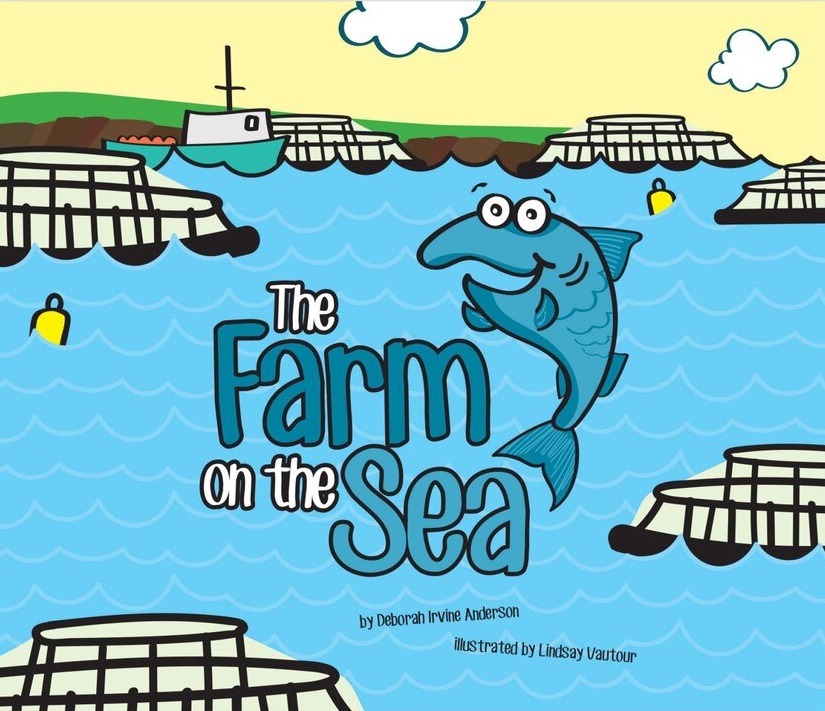Suggested Teaching & Learning Activity
Responding Personally to The Farm and the Sea
- Encourage students to make personal connections to The Farm on the Sea (e.g., how it made them feel, what it reminded them of, which part they liked best).
- Provide opportunities and encouragement to respond to the text in a variety of ways, e.g., - drawing - painting - sculpture (e.g., clay) - talking - retelling orally, or through drama, art, or writing. For example, students could construct a diorama of a salmon farm.
- Provide additional books about salmon, farmers, etc.
- As suggested in the curriculum: Use the Visual Thinking Strategies format to start class discussion when viewing the artwork in The Farm on the Sea. Prompts include: Tell me what's going on in this picture, What do you see that makes you say that?, What more can we find?
-
As suggested in the curriculum: Use the Describe/Analyse/Interpret format to start class discussion when viewing the artwork in The Farm on the Sea. Prompts include:
1. Tell me what's going on in this picture, What do you see that makes you say that?, What more can we find?Be an art detective... “What do you see?”
2. Think like an artist... “What colours did the artist use? What shapes? Lines? What seems closest? What did the artist do to make it seem close? What seems far away? Can you trace the horizon line? What takes up the most space?...
3. Feelings... “Let’s imagine we could step into this picture. What would you hear? What would you smell? How would it make you feel?”
4. Deciding... “Decide on a title for this artwork. What would you call it?”
Offline Resources and Activities
Online Activities
Curriculum Connections
Grade K-2
- Visual Arts
- Strand 2: Connect
- GCO 1: Students will be expected to create, independently or collaboratively, a variety of artworks.
- Students will be expected to:
- K-2.1.1 Create art for a variety of reasons and recognize that there are many kinds of visual arts.
- K-2.1.2 Create artworks based on memory, mood, feelings, imagination, and fantasy including responses to music and literature.
- Students will be expected to:
- GCO 4: Students will be expected to reflect on and respond to their own and others’ art works.
- Students will be expected to:
- K-2.4.1 Look at and respond to art in a variety of ways.
- Students will be expected to:
- GCO 1: Students will be expected to create, independently or collaboratively, a variety of artworks.
- Strand 2: Connect
Grade 3
- Visual Arts
- Creating, Making, and Presenting
- GCO 1: Students will explore, challenge, develop, and express ideas, using the skills, language, techniques, and processes of the arts.
- 3.1.2 Create images based on sensory experiences and imagination that express a mood, feeling, or emotional response and convey personal meaning.
- GCO 2: Students will create and/or present, collaboratively and independently, expressive products in the arts for a range of audiences and purposes.
- 3.2.1 Create art for a variety of reasons and recognize that there are many kinds of visual arts.
- GCO 3: Students will be expected to demonstrate critical awareness of and value for the role of the arts in creating and reflecting culture.
- 3.3.5 Draw upon experiences from their personal, social and physical environments as a basis for visual expression.
- GCO 7: Students will be expected to understand the role of technologies in creating and responding to expressive works.
- 3.7.3 Make choices and decisions about tools and materials in the creation of art objects.
- GCO 1: Students will explore, challenge, develop, and express ideas, using the skills, language, techniques, and processes of the arts.
- Creating, Making, and Presenting
Grade K-1
- English Language Arts (Atlantic Canada)
- Reading and Viewing
- GCO: Students will be expected to respond personally to a range of texts.
- Students will be expected to:
- Respond personally to texts in a variety of ways.
- Express opinions about texts and the work of authors and illustrators.
- Students will be expected to:
- GCO: Students will be expected to respond personally to a range of texts.
- Reading and Viewing
Grade K-2
- Visual Arts
- Strand 2: Connect
- GCO 2: Students will be expected to explore skills, processes and materials.
- K-2.2.2 Explore basic art skills, techniques, and vocabulary through a wide
range of materials and available technologies. - K-2.2.3 Using a variety of materials, visually communicate stories, ideas, and
experiences.
- K-2.2.2 Explore basic art skills, techniques, and vocabulary through a wide
- GCO 2: Students will be expected to explore skills, processes and materials.
- Strand 2: Connect





